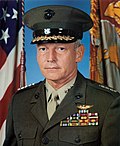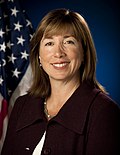| Deputy Administrator of the National Aeronautics and Space Administration | |
|---|---|
 Seal of NASA | |
Incumbent since January 20, 2025Vacant | |
| National Aeronautics and Space Administration | |
| Style | The Honorable [1] (formal) |
| Reports to | Administrator of the National Aeronautics and Space Administration |
| Seat | Mary W. Jackson NASA Headquarters, Washington, D.C. |
| Appointer | The president with Senate advice and consent |
| Term length | At the pleasure of the president |
| Constituting instrument | 51 U.S.C. § 20111 |
| Inaugural holder | Hugh Latimer Dryden |
The deputy administrator of the National Aeronautics and Space Administration is the second-highest-ranking official of NASA, the national space agency of the United States. Administrator of NASA is NASA's chief decision maker, responsible for providing clarity to the agency's vision and serving as a source of internal leadership within NASA. The office holder also has an important place within United States space policy. [2]



















